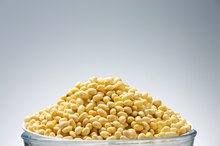Soy Formula vs. Lactose-Free Formula
When it comes to your infant's diet, nothing beats breast milk. But if you can't breastfeed or need to supplement, make sure your baby gets the right formula. Soy and lactose-free are two options -- but don't give them to your infant without a good reason. Knowing the differences between the two can help you make an informed decision, but consult your child's pediatrician to be sure a formula is right for your child.
Formula Makeup
The primary difference between soy and lactose-free infant formulas is the protein source. Soy is the protein in soy infant formula, while cow's milk is the source of protein in lactose-free infant formula. Both formulas generally use sucrose, cornstarch, corn syrup or maltodextrin as a source of carbohydrate, but you can find soy-based formulas that are corn- and sucrose-free. Fat content in either formula is a combination of vegetable oils plus the essential fats DHA and ARA.
Who Needs What
Alimentum & Corn Allergy
Learn More
Neither soy nor lactose-free formulas contain lactose. The American Academy of Pediatrics, or AAP, recommends both types for infants diagnosed with galactosemia, a disorder that affects how a baby processes the sugar galactose, found in lactose. The AAP also recommends both formulas for infants with congenital lactase deficiency; babies with this genetic mutation cannot make enough lactase, the enzyme that helps digest lactose. Lactose-free infant formula is also recommended for infants with primary lactase deficiency, an inherited condition. Some parents choose soy formula because they do not want their infants to consume animal products.
Comparing Nutrition
When it comes to nutritional content, there are differences between the two formula types. Soy infant formula is higher in protein than lactose-free -- 13 percent compared with 9 percent -- because soy protein has a lower biological value than cow's milk protein. Soy formula also contains higher amounts of calcium, phosphorus, zinc and iron. That's because the phytates and fiber in the soy formula interfere with the body's absorption of these minerals.
Milk Allergy
Enfamil Gentlease Nutrition
Learn More
If your infant is allergic to milk, neither of these formulas is a good choice. While you might think that a soy-based formula would be fine, 10 to 14 percent of infants with a cow's milk allergy also have an allergy to soy, according to the clinical book "Pediatric Nutrition." Hypoallergenic infant formulas that contain hydrolyzed proteins are recommended for infants with cow's milk allergy.
Related Articles
References
- MedlinePlus: Infant Formulas
- American Academy of Family Physicians: Infant Formula
- Pediatric Nutrition; Patricia Samour & Kathy King
- The Baylor Pediatric Nutrition Handbook for Residents; Baylor College of Medicine
- Medical News Today: What is Lactose Intolerance? What Causes Lactose Intolerance?
Writer Bio
Jill Corleone is a registered dietitian and health coach who has been writing and lecturing on diet and health for more than 15 years. Her work has been featured on the Huffington Post, Diabetes Self-Management and in the book "Noninvasive Mechanical Ventilation," edited by John R. Bach, M.D. Corleone holds a Bachelor of Science in nutrition.









